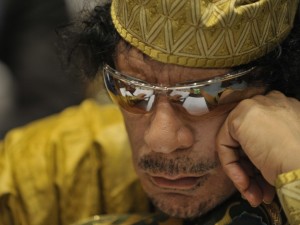 Even Muammar Gaddafi deserved a private death
Even Muammar Gaddafi deserved a private death
By Mark Lawson,Friday 21 October 2011 08.30 EDT
…
Western foreign policy in recent years has combined with the democratisation of filmed images to create a stark new problem for media organisations: the existence of images of regime-changed leaders before, during and after the moment of death. Scenes of the hanging of Saddam Hussein were widely broadcast and printed, as snuff shots of Osama bin Laden surely also would have been if the American government had not decided (correctly, I think) to suppress the material filmed by its hit squad.
And the pictures of the terrified, wounded and then possibly dead Muammar Gaddafi used on TV bulletins and the print and online editions of newspapers in the last 24 hours seemed to me to be, by some distance, the most graphic and distressing representations we have ever seen of a recognisable individual during his final moments. The sense that these images significantly extended journalistic incursions across the historical borders of editorial taste is underlined by the intense objections on media sites, including the Guardian and the BBC.
Traditionally, shots of people in terminal extremis have been one of the strongest taboos for broadcasters and newspapers, leading to intermittent controversies when a medical or science programme on TV has shown (with the consent of the patients and their family) the moment of death. Such fusses result from a residual feeling in society that there should be dignity and privacy in death and the obligation imposed on editors (by such organisations as the PCC and Ofcom) not to cause unnecessary or unheralded offence to sensitive consumers.
Two developments – one cultural, one technological – have challenged this editorial decorum with results first noticed with the execution of Saddam five years ago and climaxing in the Gaddafi gallery yesterday. A common argument in favour of explicit pictures is that, in an instinctively suspicious and conspiratorial age, national and international communities, a global village of Doubting Thomases, will only accept that the villain is dead if they have seen the corpse. But this thesis is weakened because the reflex incredulity of our times necessarily extends even to any images that do emerge: when the Americans held back the Bin Laden death shots, online photographic pranksters mocked-up their own.
The most significant (and probably irresistible) change, however, is that the dissemination of contentious images has now largely left the desks of editors and regulators. Symbolically and crucially, the footage of Gaddafi’s capture and assault was shot not by a crew but by a crowd on cellphones. TV or newspaper editors who ethically decide to bin the most distressing images know, unlike their predecessors, that the views will be generally available elsewhere and that curiosity will draw a large part of the audience there.
But the risk is the development of a culture of death porn. For me, as a simple moral position, Gaddafi merits as much privacy in his final extremities as did his victims in the Lockerbie bombing: a germane example from the past of a time when the media by common consent suppressed horrific images in the cause of taste and privacy.
The issue is most acute for newspapers because a front page (either paper or online) is designed to take readers unawares and attract the curiosity of passing trade. Unlike in television, no warning can be given of what is about to be seen, although, for me, the standard warnings given by broadcasters yesterday (“images which some viewers may find offensive”) were inadequate for the leap in morbid detail that some of these pictures represented.
Though having largely caused the problem by making editorial control of questionable images so much harder to impose, online media may also be best placed to solve it. The most potentially upsetting images could be kept from general bulletins and front pages and restricted to online boxes which, like the curtained-off sections of art galleries, allow admission only to those who know what they are getting. Even presidents, Bill Clinton once pleaded, deserve a private life. Even tyrants, I would argue, deserve a private death.
…
http://www.guardian.co.uk/commentisfree/2011/oct/21/muammar-gaddafi-death-images-media or http://bit.ly/rhJTTF
